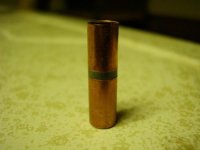Cale, (Caroby) in your post number 31, you mentioned how you once 'popped' a jacket when 'sneaking up' on the right core seating pressure. Thanks for bringing that up and thanks also for posting the photo of the separated jacket so everyone will understand what we are talking about.
Of course, as you know, when one is adjusting the core seater die, the jacket length shortens as the core and jacket are expanded up. This shortening continues as the die is gradually screwed down in the press but there comes a point where the jacket suddenly begins to grow in length. I believe this marks the point where you have just gone a bit too far and should back the die up slightly. Skip Otto was the first to explain this to me, and of course at the time, it went in one ear and out the other.

It was Gary Sinclair, several years later, who finally cleared this up for me.

Thank you Gary.

Guys, I gotta' tell you a funny story.

After reading about core-stripping in Harold Vaughn's book, I began thinking of ways to increase friction between core and jacket. One of these hare-brained ideas turned out to be hilarious!

As model-building kids, most of us soon learned to solder wires and other small items together with a soldering iron. I got to thinking about how copper and lead/solder always seemed to have an affinity for each other and wondered if maybe I could 'solder' the cores in place.

But how! Hmmmm,, Let's see,, I could touch a soldering iron to the base and hold it there till the lead core melted. Nah, that wouldn't work; the core would wind up lopsided. I know

I could place the bullets base down in a pan and heat them up on my wife's electric stove! Yeah, that'll work! (Wrong)
I got to looking at the heating elements on the stove and noticed they were nice and flat.

I thought, 'Why not just place the bullets in a row around the heating element and then turn on the power." Of course.

So,,, I placed about twenty bullets on the heating element and turned up the heat.

It wasn't long before the bullets took on a silver hue and before I could switch the power off they turned black! Oh s--t !

I knew the cores had melted because a few of the bullets had little drops of lead that bubbled up out of the meplats and ran down the side of the jacket into the drip pan of my wife's stove.

So,, there they were, my beautiful, black, heat-treated bullets still hottern' hell. Now what?
I decided to use tweezers to remove the hot bullets from the stove and dropped them, one by one, into a pan of cold water. This caused some of the black oxide to flake off revealing a nice clean copper surface below. I had heard somewhere that vinegar would remove oxidation from copper and brass so I poured a little Hienz apple cider vinegar into the pan and let the bullets soak for a while. After swishing them around in the vinegar bath for a little while, the bullets came out shiny and clean with not a trace of oxidation but the jackets had sort of a dull, etched appearance. I thought, "I know what; I'll put them in my case tumbler overnight and polish 'em up!
Next morning, the bullets came out of the tumbler looking brand new. I put them in a zip-lock baggy and headed for the tunnel. What the hell, might as well see if they'll shoot.

To say, "Those bullets didn't shoot so pretty good" would be the kindest thing one could say. They wouldn't shoot in a basket! I'm talking 3 and 4 inch groups at 100 yards, in the tunnel. Needless to say, I haven't tried that again.
So beware.

If someone tries to give you some bullets that look like they've been soldered,, start runnin' backwards!
Later,
Gene Beggs


